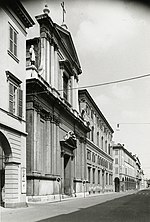Automobili Stanguellini
1879 establishments in Italy1981 disestablishments in Italy24 Hours of Le Mans teamsCar manufacturers of ItalyDefunct motor vehicle manufacturers of Italy ... and 4 more
Formula Junior carsItalian automotive pioneersItalian racecar constructorsSports car manufacturers

Automobili Stanguellini was an Italian sport cars manufacturer based in Modena. The company was founded by Vittorio Stanguellini and was mostly active between 1946 and 1960. They produced racing cars until 1981, when Vittorio Stanguellini died. Since then, the company has been run by his son Francesco and offers service for the restoration, maintenance and operation of historic racing cars.
Excerpt from the Wikipedia article Automobili Stanguellini (License: CC BY-SA 3.0, Authors, Images).Automobili Stanguellini
Via Giuseppe Campi, Modena Punta
Geographical coordinates (GPS) Address Nearby Places Show on map
Geographical coordinates (GPS)
| Latitude | Longitude |
|---|---|
| N 44.6361107 ° | E 10.9480236 ° |
Address
Via Giuseppe Campi 33
41125 Modena, Punta
Emilia-Romagna, Italy
Open on Google Maps








